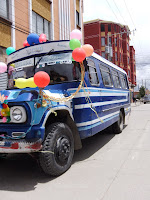
Ok, so I hate starting every post with an apology and an excuse, but it's so hard not to! I was so ambitious, so optimistic, but really have nothing to say for myself. I beg your forgiveness. Part of the reason I've been putting this off, though, and also the reason I was originally so excited, is that buses really are a big deal here. Even the BBC says so. They have their own weekly column in my favorite newspaper and have become a popular icon of the city in the few tourist-friendly souvenir markets, which feature countless impressionistic paintings like this one. And they are central to the next project of a certain junior faculty member in a midwestern public university. So I wanted to do them justice. But that's stressful. So here's what I've got.

There are several different classes of buses in Lagos, but the beat up old yellow Volkswagen "Danfo" vans like the one above are easily the most iconic. Theyare completely hollowed out and installed with three or four hard benches instead of seats, fitting up to 22 people, including one drop seat for the conductor, who hangs out the side of the van as it becomes full, collecting fares and bellowing out the next stop. A favorite Lagos memory is the first time I saw these guys really in action, when they have to actually jump out of the van as it's still moving and then run along side it as passengers exit and new ones enter, all still while the bus is in motion! I don't quite have footage of this (of course, excuses excuses), but here's a conductor getting ready to hang out...

Bus decor is another beloved danfo institution. You can see decorative reflectors on the above piece, and some superfluous antennae on this one.

This one sports a number of common painted motifs -- the Nigerian flag, bad Nike swooshes, and praises to God:

Here's one of my friends' personal favorites (the buses are green on in the super special Victoria Island area), with praise for both family and Chelsea football, of course.

As you can imagine, with 22 people in a van built for what, 8?, danfo are quite crowded, hot, sweaty, and sticky, with everyone sitting shoulder to shoulder jammed in rows with little ventilation. Not extremely desirable, and not the safest either. They break down often along the side of the road, but what's worse, the motor parks where you catch them and change lines are notorious for gangs of area boys, and I've heard too many stories where the driver, conductor, and other "passengers" are all in cahoots to rob you of your money at some remote off-route destination.
So, with all that, I don't really take them by myself too often, usually only riding them with friends who know the system a bit and can give me a heads up if any trouble comes our way. Not surprisingly, then, most of my expat friends have never taken them, and find the idea of it just ridiculous. Which is why, at my friend's Nigeria themed going away party (based primarily off of local funeral traditions--thus the aso ebi matching nativewear), he decided to hire one for the night, and we all posed for photos in it. We definitely earned the crazy oyibos award that night, shocking the police at every checkpoint with a bunch of giggly white people giving the thumbs up from a beat up old danfo...

Besides the danfo, some of the other bus varieties include the much bigger Molue variety, which usually hold well over their official capacity of 44, with people standing in the aisles and hanging out the door along with the conductor. They were also the inspiration for Fela Kuti's song "Suffering and smiling" with the following lyrics:
Every day my people dey inside bus
Every day my people dey inside bus
Forty-nine sitting, ninety-nine standing
Them go pack themselves in like sardine
Them dey faint, them dey wake like cock
Anyway this particular molue has an aesthetic that looks straight of Anthropolgie catalogue, I think.

And finally, there's the new BRT (Bus Rapid Transit) and LagBus system, which much more like the buses we see in the US. The much beloved governor of Lagos, Babatunde Fashola, is credited getting these "modern" buses out on the street, and, what's really impressive, actually enforcing at least some of the dedicated lanes for them on the traffic-plagued Lagos highways. Here, we see one plastered in advertisements for Gov. Fashola himself, who is up for re-election next month.
 And well I wanted to share a video from the road but the technology gods just won't have any of it -- blogspot won't let me upload it directly and I even opened a youtube account only to have them refuse the format as well. I will work on this for the future, but in the meantime leave you with this borrowed footage instead. (It's kinda long, but the first couple minutes give you the idea...)
And well I wanted to share a video from the road but the technology gods just won't have any of it -- blogspot won't let me upload it directly and I even opened a youtube account only to have them refuse the format as well. I will work on this for the future, but in the meantime leave you with this borrowed footage instead. (It's kinda long, but the first couple minutes give you the idea...)

